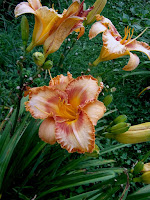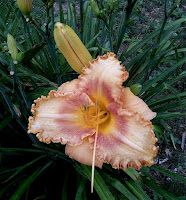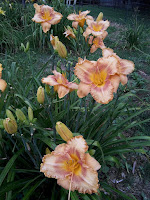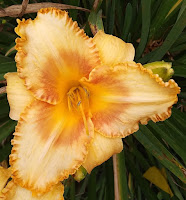Cultivar Name: Butterscotch Queen
Seedling Number: KQMB 44
Bloom Diameter: 4”
Scape Height: 28”
Branches: 3
Bud Count: 14
Bloom Season: Mid-Late
Rebloom: Yes
Color/Description: Caramel yellow-orange petals with orange to yellow double edge culminating with piecrust ruffles and some tentacles and teeth, above raspberry eye and glowing orange throat.
Ploidy: Tet
Bloom Habit: Diurnal
Foliage: SEV
Fragrance: UNK
Pod Parent: Korean Queen
Pollen Parent: Mystic Butterfly
Year Bred: 2016
Rust Resistance: Unknown, produced after rust resistance screening program had concluded. pod parent was A+/5 years and pollen parent showed B-level resistance.
Fertile: Both ways, pollen is easier.
For a complete list of my available daylilies and pricing, click here.
Comments: Korean Queen is proving to be a great parent that can produce seedlings much more advanced than Korean Queen appears to be at first glance. Korean Queen is a cross of the Korean form of H. fulva with the fancy modern tetraploid Queen's Circle, so she carries many advanced phenotype genes, even if you can't always see them. Butterscotch Queen was one of the first seedlings I saw from Korean Queen that showed me just what is possible in terms of segregating fancy tetraploid phenotypes back out of Korean Queen. The cross to Mystic Butterfly was just an afterthought from which I produced 8 pods, with around 70 seeds. I saw quite a range of phenotypes in the seedlings. Some were purple, some lavender, some bright yellow, some melon, some near-white yellow, some orange. This one, which is now Butterscotch Queen, was the only one that showed the darker eye/edge on a drastically lighter petal background color, along with tentacles and a wire yellow edge. I thought tis particular combination of colors was unique and very attractive, and it has only grown on me more over the years. I have gone on to produce many more seedlings from Korean Queen with the eye/edge phenotype in multiple color combinations.
Butterscotch Queen stood out from the first flower. The strong edge/eye is very visible. The yellow wire-edge and ruffles show on all the flowers. It often shows tentacles on the petal edges. The petal color starts the day a light caramel-orange tone, then fades through the day to a lighter yellow-caramel that is creamy or buttery. The eye occasionally shows a distinct appliqué throat, as you can see in the first image below. Fertile both ways, but pods are harder, just like with pollen parent Mystic Butterfly. The pollen is very good, and I have produced pods on Butterscotch Queen, and she can produce some really gorgeous seedlings with fancy flowers.
The flowers are in the mid-late to late season, when so many cultivars have completely stopped flowering. That, along with the attractive flowers, makes for a striking clump at a time of the year when color is sorely needed. The foliage is semi-evergreen in my garden in warm winters, but can go dormant here in extremely cold years. It is extremely cold hardy, and because it flowers late in the season, late freezes don't seem to impact flowering, as it can with earlier flowering types. Korean Queen is performing well throughout the country, and I suspect that Butterscotch Queen will have good cold hardiness further north, based upon what I have seen it do here in Polar Vortex years. With that said, the Florida-bred pollen parent, Mystic Butterfly, has survived well in my garden since maybe 2013 or 2014, going through more than one Polar Vortex, and we still have a clump in my mom's garden. Mystic Butterfly is an early bloomer and susceptible to late freezes, so its first round of flowers are often damaged or fail to mature. As it reblooms, Mystic Butterfly produces later flowers in my garden, even when the first round of scapes are negatively impacted. That allowed me to use it in breeding and produce a few good seedlings out of it that I have continued on with in my program, and while many of its seedlings have been too tender for my goals, some have been great, like Butterscotch Queen.
Butterscotch Queen combines the hardy, vigorous species genetics coming from the Korean fulva grandparent, and combines that with the fanciest of eye-edge genes through ancestor Queen's Circle and pollen parent Mystic Butterfly. This one has so much breeding potential. I have mainly taken it over my tall base plants with very good results, but I think in programs focused more toward fancy flowers and less toward giant plant traits, Butterscotch Queen could do even more than it has in my program. I think combined with some of its fancy southern cousins, you might get some really wonderful surprises in your seedling bed, while northern hybridizers could combine it with their selected hardy fancy-flowered lines to also produce excellent fancy seedlings with tremendous vigor and cold hardiness. Multiple photos below.

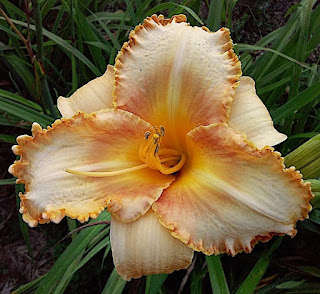

%20X%20MYSTIC%20BUTTERFLY%20111111.jpg)

